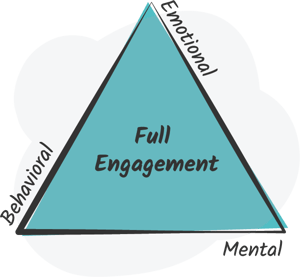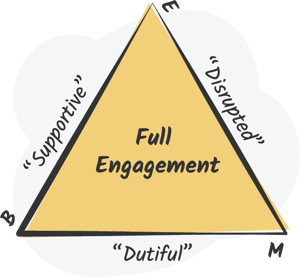MONTHLY NEWSLETTER:
Subscribe and join our community of curious HR Professionals and Managers.
Latest Article
Categories
Quick Links
Applauz Blog
Published: January 14, 2020
Last Updated: February 7, 2024
5 min read
By: Applauz

Let's look at three employee personas that help us understand what is employee disengagement, and most importantly, its root causes.
A disengaged employee is traditionally painted as a short-tempered and blatantly disruptive worker. Picture an angry and authority defiant teenager.
The reality is that the classic signs of employee disengagement manifest subtly, especially in the early stages.
Consider the following scenarios...
You work with a colleague that is "all talk, no walk"—they show up on time, socialize, and share ideas—but when it comes to executing work, they are almost always dropping the ball.

Alternatively, you work with a colleague who completes their share of the workload; however, they are emotionally absent and rarely take initiative or share ideas.
We can see that employee disengagement has many faces.
More importantly, more subtle forms of disengagement can fly under the radar for long periods.
Ultimately, illustrating these scenarios shows how dynamic and fluid employee engagement (and conversely disengagement) can be in real life.
Understanding the subtleties of disengagement helps managers identify and treat disengagement as early as possible.
By approaching disengagement from a more nuanced perspective, managers can learn to spot partial disengagement and apply interventions and solutions accordingly. And, hopefully, before turnover or severe absenteeism or presenteeism occurs.
 First, let’s start at the foundation by asking what defines and constitutes employee engagement; in other words, what does employee engagement look like?
First, let’s start at the foundation by asking what defines and constitutes employee engagement; in other words, what does employee engagement look like?
Employee engagement can be boiled down to three (3) main components:
Let's explore this idea a little bit further...
 What Does Employee Engagement Look Like?
What Does Employee Engagement Look Like?Behavioural engagement is the physical and interpersonal component of engagement; it means an employee shows up for work on time. They are punctual and respectful of their work environment and towards their coworkers. They are physically present for gatherings, meetings, and even social events. This is an essential element of engagement, but standing alone, is empty. For example, someone can show up for work but be emotionally checked out.
The emotional component is what we typically associate with employee engagement; it's related to how much someone likes their job. Not just the job itself, but the culture, people, the work in general. Someone high on this component of engagement will always be the first to take the initiative, go outside their job description, raise their hand with a question, and share ideas and thoughtfully challenge people. In short, they are involved. And will not hesitate to step outside of their assigned tasks when and if they are asked.
Mental engagement is associated with attention, focus, and determination. In short, how good an employee is at execution. An employee might show up to work (be physically present), and they may even be emotionally involved as well by sharing ideas and taking initiative, but at the end of the day, can they buckle down, stay on task, attain goals, and deliver high-quality work. Or, are they all talk, no walk?
Based on the model above, we can picture the interplay of the three main components of engagement (mental, emotional, and behavioural).
As a result, we can paint a picture of the various types of “disengagement personas” that exist at work on the day-to-day.
An important note about remaining reasonable when it comes to disengagement. It would be unrealistic to expect high scores on all three dimensions of engagement on a consistent basis.
 That is because engagement is not a binary state. In other words, not an "on/off" switch. Employee engagement is dynamic. It exists in shades of grey and will ebb and flow in the same employee throughout their tenure.
That is because engagement is not a binary state. In other words, not an "on/off" switch. Employee engagement is dynamic. It exists in shades of grey and will ebb and flow in the same employee throughout their tenure.
Ultimately, this model serves to paint a picture of an “ideal” and fully engaged employee, so that you, in turn, use it as a standard. With that standard in place, you can conceptualize what the “ideal” engaged employee looks like at your company. For example, perhaps in your company, you’re OK with leaving some wiggle room in terms of the behavioural component engagement. As long as the employees boast high scores on the emotional and mental components.
Now, let’s jump into the three personas…
 1- The “Superficial” Employee
1- The “Superficial” Employee When an employee scores high on both the behavioural and emotional components of engagement, but low on the mental component, we can say they are considered “superficial.”
They seem engaged -- but it's superficial. That is because they show up for work and meetings on time. They are even very friendly with people, and are also emotionally involved with their department and work culture as a whole. They will share ideas and not be afraid to speak up.
However, behind the outwardly cheerful facade, they are disengaged because they fall behind in their ability to actually execute and perform. These types of employees can be tricky to manage since they are well-liked. They can go unnoticed for months even years, and it can be difficult to correct their behaviour, even if they are just skimming by.
A tell-tale sign is when words and actions don't align. So although they speak up with great ideas at meetings, they have trouble executing and delivering on what they promised. The issue can also manifest as delivering work that doesn’t meet the company's standards, procrastinating and missing deadlines, or abusing the break and lunch policy.
 2- The “Disrupted” Employee
2- The “Disrupted” Employee When an employee scores high on both the emotional and mental components of engagement, but low on behavioural, they can be said to show "disrupted" engagement.
This person is emotionally involved in their role and the company's mission. They will share ideas and not hesitate to raise the bar. Unlike the Superficial, they are also great executors; they have a strong sense of duty and the ability to stay focused and deliver quality work as promised.
However, they score low on the behavioural component — they are often late or absent from work, meetings, and other social events at work. They are sometimes perceived as flaky and interpersonally distant. They're not afraid to share their ideas, but fail to praise colleagues for theirs. They may disappear without much justification; however, when they do come back, they can complete their work with the same quality.
 When an employee scores high on both behavioural and mental components, but low on the emotional component, we can call them a “dutifully” engaged employee.
When an employee scores high on both behavioural and mental components, but low on the emotional component, we can call them a “dutifully” engaged employee.
These are the types of employees that have a solid work ethic; they are punctual, respectful, organized — always able to stay on task and deliver what is asked of them.
However, they lack the “emotional” component, which means they don’t feel a deeper sense of connection and dedication to their job, work, or mission of the company. As a result, they don’t get involved any more than they have to in meetings or any other aspect of work. In short, they do the minimum of what is required, but they usually do it well. Measuring Employee Engagement Without Surveys
Measuring Employee Engagement Without Surveys
This model serves to illustrate employee engagement conceptually, but also helps to measure and quantify engagement without having to survey your employees.
Managers can assign a numeric value out of 10 for each dimension based on your criteria. For example, each time an employee is late for work during the month, you deduct 0.5 points from the behavioural component.

At the end of the month, you can generate an overall “engagement” score for each employee.
This can be a great way for managers of smaller teams to quantify and measure employee engagement, especially if they lack the time or resources to formally audit and survey employee engagement regularly.
After painting a picture of these three “personas,” I am sure you can think of colleagues (or even previous jobs you’ve held) where you experienced disengagement of this nature.
As mentioned before, some businesses may not give equal weight to all three components of engagement.
It’s up to each company to decide what the optimal level of engagement looks like in their business. Then, they may go to identify the employees who are falling short and apply interventions and solutions accordingly.
Category Tags
Employee Engagement
MONTHLY NEWSLETTER:
Subscribe and join our community of curious HR Professionals and Managers.

7675 Blvd Saint-Laurent,
suite 201,
Montreal, QC,
CA, H2R 1W9
7675 Blvd Saint-Laurent, suite 201, Montreal, QC, CA, H2R 1W9
Contact us
1 833 277 5289
Contact us | 1 833 277 5289
Follow us on LinkedIn:
© Copyright 2024. All Rights Reserved